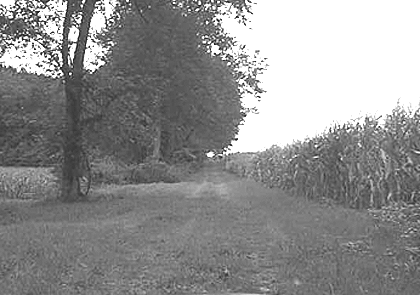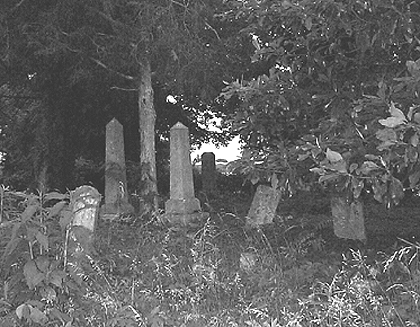The Bell Witch: The Full Account (51 page)

John and Lucy Bell have a number of
descendants, stretching from Tennessee to
Mississippi, and from Texas up through the Midwest.
There are several descendants of John and Lucy Bell
living in Robertson County, Tennessee today;
however, the author has chosen not to list their
names in this book as a matter of respect for their
privacy.
Some Bell descendants believe that “something”
was wrong in the home of John Bell, some do not
believe anything was wrong, and other Bell
descendants refuse to discuss the matter altogether.
The author wishes to state that after having met and
conversed with a number of John and Lucy Bell’s
descendants, he sees nothing at all strange or
otherwise “different” about them – they are all fine
and well-respected citizens of their communities, and
are to be commended for their diplomatic handling of
all the disinformation currently in circulation
regarding the “Bell Witch.”
What remains of the Bell farm today?
Very little is left of John Bell’s plantation. A newer
road roughly follows the old main road, which was
the Springfield and Brown’s Ford road. Now located
in the middle of a field and a good distance from the
nearest road, all that remains of the original Bell

378 P A T
F I T Z H U G H
home is a hole where the cellar was, a few rocks from
the original foundation, and some small trees
growing around the hole. The old well is nearby, and
the cemetery is on a small hill overlooking the old
homesite. The cemetery is not marked in any way,
nor is there a road leading to it. The only headstone
is the replacement of John Bell’s original headstone,
which was taken in 1951.
A section of the old Springfield and Brown’s
Ford roadbed, which was a major road during
the days of John Bell.
Can One see where the Bell home stood?
The old Bell farm is on private property, and entry
without written permission from the private
organization that owns it is forbidden. Moreover,
even if one had permission, it would be difficult to
visit the old homesite and cemetery without possibly
damaging crops. The area is being used as farmland.
THE BELL WITCH: THE FULL ACCOUNT
379
Appendix K:
Common Myths
A S WAS MENTIONED in
Appendix J
, there is
an abundance of misinformation circulating
in regards to the “Bell Witch.” When the
facts of a case are not crystal-clear or readily
available, there exists the possibility that some will,
as opposed to doing research, make hasty
generalizations and arrive at fallacious conclusions
about the case. Add to this the many years over
which the legend has been told in different and often
conflicting versions. The end-result is a plethora of
information believed by many people, but which
lacks any authoritative foundation.
In general, very few people are familiar with the
facts behind the legend of the “Bell Witch,” and as
such, it logically follows that very few generalizations
and “theories” regarding the legend are built upon a
foundation of hard, documented evidence.
Facts, in and of themselves, do not make a story.
Moreover, they serve as a general foundation and the
glue that holds the story together. The more facts
there are behind a story, the more credible the story
is. The case of the “Bell Witch,” differs significantly
from many other cases of hauntings in that the
characters, places, and dates have been proved.
Unfortunately, however, it is from this very
information that the most popular misinformation
concerning the “Bell Witch” evolved – simply because
people did not research the facts.
Add to this the fact that because the “Bell Witch”
380 P A T
F I T Z H U G H
legend involved so many characters, places and
times, even those who have done extensive research
sometimes confuse or forget the facts. The situation
that exists today, that there are as many versions of
the “Bell Witch” legend as there are people who tell it,
is the end-result. Some myths regarding the “Bell
Witch” are more common than others; and in most
cases, researching the facts pertaining to people,
places, and times can easily dispel these myths.
When the facts are understood clearly and put into
place, peoples' generalizations and “theories”
regarding the “Bell Witch” tend to become very
similar. Below, the author will address some of the
more common myths about the “Bell Witch.”
Kate Batts was the “Bell Witch”
Many books and other published accounts of the
Bell disturbances suggest that they were the work of
Kate Batts, an eccentric neighbor of the Bells. The
primary reason stems from the Spirit’s telling
Reverend James Gunn that it was “Ol’ Kate Batts’
Witch.” Moreover, this is how the Spirit earned its
nickname, “Kate.”
After this revelation to Reverend Gunn, which was
only one of many such false revelations, stories
began to develop which would support the Spirit’s
claim of having been Kate Batts’ “witch.” These
stories arose undoubtedly because of Kate Batts’
nature and character, which we discussed earlier in
this book.
The most common “theory” about Kate Batts being
the “Bell Witch” stems from an alleged dispute
between John Bell and Mrs. Batts over the sale of a
slave. There was not, in fact, any such dispute
between John Bell and Kate Batts. According to
official records, the slave dispute was between John
THE BELL WITCH: THE FULL ACCOUNT
381
Bell and
a “Benjamin Batts” around June 1, 1816.
95
Benjamin B. Batts and his family and lived more
than one mile from Kate and Frederick Batts, and
was not closely related to them. 96 oo Benjamin B.
Batts, whose wife was named Olive, died in 1842 and
is buried in the Batts Cemetery just south of Adams,
Tennessee. In addition to Benjamin B. Batts’ son,
Benjamin F. Batts (1841-1861), there was also
another Benjamin B. Batts, born in 1809.
Evidence establishing the fact that the dispute was
with Benjamin Batts, and census data showing that
Frederick and Kate Batts did not even own any
slaves during the time in question, are readily
available. 97 The author feels that with this
abundance of validated evidence, and no evidence
whatsoever connecting Kate Batts with the slave
dispute, that no such dispute ever took place
between John Bell and Kate Batts.
Another popular “theory” supporting the notion
that Kate Batts was the “Bell Witch” suggests that
John Bell and Kate Batts’ dispute was over the sale
of real estate when they both still lived in North
Carolina. While official records show that both
families once lived in the same area of North
Carolina, and that John Bell was involved in a
number of real estate transactions there, the author
has found no record of any real estate transaction
between John Bell and Kate or Frederick Batts.
Until such evidence can be found and validated, this
“theory” is false.
Another “theory” suggests that John Bell was a
wealthy bachelor and the owner of the first business
95
Red River Baptist Church Minutes (1791-1826)
, p. 180.
96 Ralph Winters,
Historical Sketches Adams, Robertson County and Port
Royal/Montgomery County TN
, 1978, p. 158.
97 See state and federal census information at Robertson County Archives, Springfield, TN.
382 P A T
F I T Z H U G H
in Adams, and that because of Fredrick Batts’
paralysis, Kate Batts desired to aggressively pursue a
romantic relationship with Bell. According to this
“theory,” he did not agree and Kate Batts “haunted”
him as a result. While Frederick Batts was indeed
an invalid and Kate Batts may very well have desired
such a relationship, John Bell was not a bachelor
and he did not own any businesses in Adams. As is
the case with the two preceding theories, this
“theory” is false.
Two records exist that prove John Bell was
married to Lucy Williams Bell. One of these is the
will of her father, John Williams, which names John
Bell as being her husband. The other record is John
Bell’s estate settlement document showing Lucy Bell
as the recipient of the dower portion of his estate. 98
John Bell did not own a business in Adams. Adams
did not come into existence until 40 years after his
death. The only businesses in the area other than
stillhouses and mills were located in Port Royal,
some seven miles away.
Another “theory” suggests that John Bell locked
Kate Batts in a smokehouse and let her hang until
she was dead. Kate Batts outlived both John and
Lucy Bell by a number of years. Like the others, this
“theory” is false.
Because of her nature and character, and the
Spirit’s claiming to have been her “witch,” Kate Batts
was nothing more than the most convenient and
logical scapegoat.
98
Robertson County Will Book 3
, pp. 267-268.

THE BELL WITCH: THE FULL ACCOUNT
383
Nestled among a clump of trees and dense
undergrowth is the Batts Cemetery near
Adams, Tennessee – a large, overgrown
cemetery that reminds us of a long-forgotten
era. Several of the most prominent figures in
the “Bell Witch” legend, such as Benjamin
Batts, rest here.
Elizabeth Bell was Abused by Her Father
There is no way to prove nor disprove that such
abuse took place; however, the author’s extensive
research has not yielded anything that would lead a
reasonable person to suspect that John Bell abused
her. Even if the author’s research did yield
something that supports this claim, this “theory”
would still be fallacious in that even if abuse could
be proved, there is sill no proof that such abuse
actually evoked a poltergeist.
While parapsychologists and students of the
paranormal tend to agree that emotional trauma,
especially on the part of an adolescent or pre-
384 P A T
F I T Z H U G H
adolescent person, is one way in which poltergeists
can be evoked; it is still not the only way. In the
many eyewitness accounts and interviews of those
who encountered the Bell disturbances published in
the Ingram book, Elizabeth Bell was always
described in a high-Spirited, congenial, happy and
good light – none of the signs that would indicate the
presence of severe emotional trauma.
Another thing to take into consideration when
discussing the abuse “theory” is that many factors
were present, any one of which could have caused
emotional trauma in the Bell home. John Bell, Jr.,
Drewry Bell, and Jesse Bell were in the military and
had fought in several wars, undoubtedly having seen
many of their friends die right before their very eyes.
John Bell had become afflicted with a medical
condition that nobody could diagnose and was
